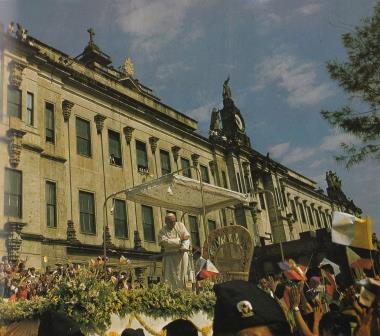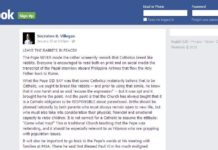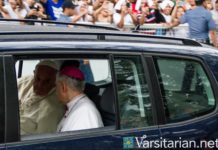AS THE only Pontifical University in Asia, UST always has the Pope’s special attention. And so when popes visit the Philippines, UST is the place where the Vicar of Christ meets the youth, the future of the Church.
Blessed Paul VI met young people at the University’s open field in 1970. Pope St. John Paul II did it twice, in 1981 and 1995. Pope Francis, the Roman Pontiff of the social media era, will follow the footsteps of his predecessors and is expected to electrify his youthful crowd on Sunday, Jan. 18.
UST Central Seminary Rector Fr. Quirico Pedregosa, Jr., O.P. said the Pontifical University is the venue for youth gatherings with the Pope because it is an “institution of the youth.”
More importantly, it is an institution under the Holy Father’s supervision, he said. UST’s flag carries the papal colors of yellow and white.
The title Pontifical University was granted by Pope Leo XIII to UST in 1902, recognizing the Dominican-run institution’s role in spreading the gospel. Pontifical universities have the authority to grant ecclesiastical degrees in theology, philosophy, and canon law.
For instilling Christian values among young Filipinos, UST was named by Pope Pius XII the “Catholic University of the Philippines” in 1947.
The Pope and the Holy See are part of the governance structure of the campus to ensure that it plays an integral role in strengthening the Catholic faith in the country.
The Pontiff appoints and confirms the rectors of the University. Names of candidates for the rectorship are sent to the Vatican for confirmation.
‘Molto bella’
Blessed Paul VI, the first pope to set foot in the country, visited UST on Nov. 28, 1970 to meet 150 bishops and priests at the UST Medicine Auditorium and address UST, the “university world of the Philippines.”
In his speech, Pope Paul VI lauded the youth’s dynamism and sensitivity in their desire to involve themselves deeply in the Church.
The Holy Father was impressed with the warm welcome given by UST and considered it as “contentisimo,” which means, most happy. He also described the University as “molto bella” – very beautiful.
“It is a university which is one of the most renowned for the richness of its history, one of the most important in number of students and one of the most well-known for the care it devotes to education of high quality,” he said.
More than 60,000 young people gathered anew for a prayer rally at the UST grounds during the visit of Pope St. John Paul II on Feb. 18, 1981, a month after martial law was lifted in the country.
Rector Fr. Frederik Fermin, O.P. considered the second papal visit as proof of the pope’s special love and concern for the Filipino people.
John Paul cited the “cordial and generous hospitality” of the “illustrious” University. He called on students to help evangelize culture. “As Catholics yοu must confess Christ openly and without embarrassment in the university environment that is yours. In this way yοu are also contributing to maintaining the Catholic character of your University in its institutional commitment to the Gospel of Christ as proclaimed by the Catholic Church,” he said.
After more than a decade, John Paul II returned to the Philippines for the 10th World Youth Day Celebrations in 1995, during which UST hosted the 5th International Youth Forum (IYF).
The Pontiff was welcomed by about 200,000 young people waving yellow and white flaglets and cheering “John Paul II, we love you!” to which he replied, “John Paul II, he loves you!”
He offered Mass before IYF delegates at the St. Thomas Chapel of the Central Seminary before addressing the crowd at the UST field. The Holy Father began his speech on how special UST was in the eyes of the Pope. “As a Pontifical University, Santo Tomas has a special right to the Pope’s attention,” he told the Filipino youth.
“What does the Church look for in Filipino youth? For help in saving your own generation from the futility, frustration and emptiness in which so many of your contemporaries find themselves. When I think of all the young men and women who should be the strength, the hope and even the conscience of society, but instead are caught in a web of uncertainty, or are desperately seeking happiness along paths that cannot lead to happiness – then I pray all the more that the young Catholics of the end of the twentieth century will come to an ever more profound knowledge of Jesus Christ and will be convinced of the marvelous challenge and adventure which he represents for every one of us,” Pope St. John Paul II said.
Papal relics
Blessed Paul VI and St. John Paul II’s visits are remembered through relics preserved in the UST Museum and Central Seminary.
Pope Francis canonized John Paul II in April 2014 and beatified Paul VI in October 2014.
There are two classes of relics, the first and the second classes. First-class relics are those that come from a saint’s body, while second-class relics are material things a saint used.
Second-class relics found in UST are vestments worn by St. John Paul II when he offered Mass at the University in 1995. Another is his papal chair that is displayed at the UST Museum.
The Central Seminary holds custody of the vestments, which includes a chasuble and an inner stole.
Blessed Paul VI gave symbolic gifts to the University: a gold chalice and a gold ciborium, signifying the unity of the Church with the youth.
Bro. Dave de la Cruz, organizer of the “Totus Tuus” tour of relics of St. John Paul II, said a pope’s visit should be viewed as a blessing more than anything else.
“It is a gift of presence of the Pope and the gift of a challenge to set the world on fire through the gospel and truth as what the venerable Dominican fathers instill in every student,” De la Cruz said. Arianne F. Merez and Karl Cedrick G. Basco











